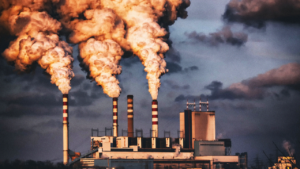Physical Address
23,24,25 & 26, 2nd Floor, Software Technology Park India, Opp: Garware Stadium,MIDC, Chikalthana, Aurangabad, Maharashtra – 431001 India
Physical Address
23,24,25 & 26, 2nd Floor, Software Technology Park India, Opp: Garware Stadium,MIDC, Chikalthana, Aurangabad, Maharashtra – 431001 India

CLAIM
‘Greenhouse gases are responsible for climate change’ claim is a hoax
FACT
Scientists have concluded that human-caused greenhouse gas emissions are primarily responsible for climate change. Human activity such as the burning of fossil fuels has led to a change in the concentration of greenhouse gases which is leading to global warming resulting in climate change.
SOURCE OF THE CLAIM
We found a video on Facebook which had this claim, among a few others.
WHAT THEY SAY
The declaration that greenhouse gases are responsible for climate change is a hoax. Greenhouse gases can have no impact on the climate as they are negligent in comparison to the vastness of the atmosphere. The whole thing is just a conspiracy and nothing else.
WHAT WE FOUND
There is a recent shift in the climate change misinformation/disinformation narrative from outright “climate denial” to “solutions denial”. This has happened perhaps because ‘scientific evidence for climate change caused by humans is too obvious to ignore or deny anymore. Reducing the use of fossil fuels which has a direct impact on the concentration of greenhouse gases is a solution and refusing to adopt or believe now that greenhouse gas emissions are primarily responsible for climate change is delaying a necessary climate policy.
GREENHOUSE GASES
After sun rays reach the earth’s surface, a portion of it radiates back towards space as heat or infrared radiation, a greenhouse gas is a gas that absorbs this infrared energy resulting in the trapping of heat in the atmosphere which warms up the surface of the earth. This is also known as the greenhouse effect and takes place in natural as well as human-induced ways.
NATURAL GREENHOUSE EFFECT
The natural greenhouse effect of the Earth is because of the naturally occurring trace amounts of water vapor (H2O), carbon dioxide (CO2), methane (CH4), and nitrous oxide (N2O) in the atmosphere. These gases allow solar energy to reach the surface of the earth but trap infrared radiation emitted by the Earth resulting in the heating of the surface making it conducive to the survival of life. Earth would be approximately 33 °C cooler in the absence of this natural greenhouse effect and Earth’s average temperature would be a chilly -18 °C.
HUMAN-INDUCED GREENHOUSE EFFECT
The natural concentration of greenhouse gases in the atmosphere has been disturbed by human activities like the excess burning of fossil fuels like coal, oil, and natural gas. Emissions from these burnings have led to a rise in the concentrations of greenhouse gases like (mainly) carbon dioxide, methane, nitrous oxide, hydrochlorofluorocarbons (HCFCs), hydrofluorocarbons (HFCs), and ozone in the lower atmosphere. This has led to the thickening of the blanket-like layer of greenhouse gases in Earth’s atmosphere which in turn is leading to the trapping of excess heat. Thus global temperatures are constantly rising because of this excess heat getting trapped close to the Earth’s surface.
RISING LEVELS OF CO2 & GLOBAL WARMING
Carbon dioxide (CO2) is the primary greenhouse gas that is emitted through human activities like the burning of fossil fuels. CO2 consisted of about 79% of all U.S. greenhouse gas emissions in 2020.
Total U.S. Emissions in 2020 = 5,981 Million Metric Tons of CO2 equivalent (excludes land sector). Source: https://www.epa.gov/
Though the gas is naturally existent in the atmosphere, anthropogenic emissions have not only disturbed the natural carbon balance among the atmosphere, soil, ocean, plants, and animals by increasing the levels of carbon dioxide in the atmosphere but also hampered the function of natural sinks like soils and forests to store CO2 thus lessening chances of it reaching dangerous levels in the atmosphere.
Source: https://www.eia.gov/
Post-industrial revolution there has been an abnormal and significant rise in the levels of CO2, the result of which is being witnessed in the soaring global average surface temperatures. While it is true that the natural processes can absorb some of the human-induced CO2 emissions, around 1950, CO2 emission levels reached too big a figure to be handled naturally (absorb carbon). In 2021, worldwide CO2 emissions rebounded to their highest level in history. The main factor behind this was the increased use of coal which led to an increase in CO2 emissions by more than 2 billion tonnes.
According to the flagship report published in the ‘Global Energy Review: CO2 Emissions in 2021’, “CO2 emissions in India rebounded strongly in 2021 to rise above 2019 levels, driven by growth in coal use for electricity generation. Coal-fired generation reached an all-time high in India, jumping 13% above its 2020 level.”
While Carbon dioxide absorbs less heat per molecule in comparison to the other greenhouse gases, the gas is more abundant and is available in the atmosphere for a much longer duration. Scientific research has pointed out that two-thirds of the total energy imbalance that is leading to a rise in temperature of the Earth’s surface has been caused by an increase in atmospheric CO2.
GLOBAL WARMING LEADING TO CLIMATE CHANGE
Global warming is leading to climate change as the world is now warming faster than at any point in recorded history. Warmer temperatures have brought about a change in weather patterns leading to a disruption in the normal natural balance. In the Indian context, climate change is leading to the melting of Himalayan glaciers and changes to the crucial Indian monsoon. Heat waves and incessant floods are becoming rampant disrupting normal life in the region.
Category: